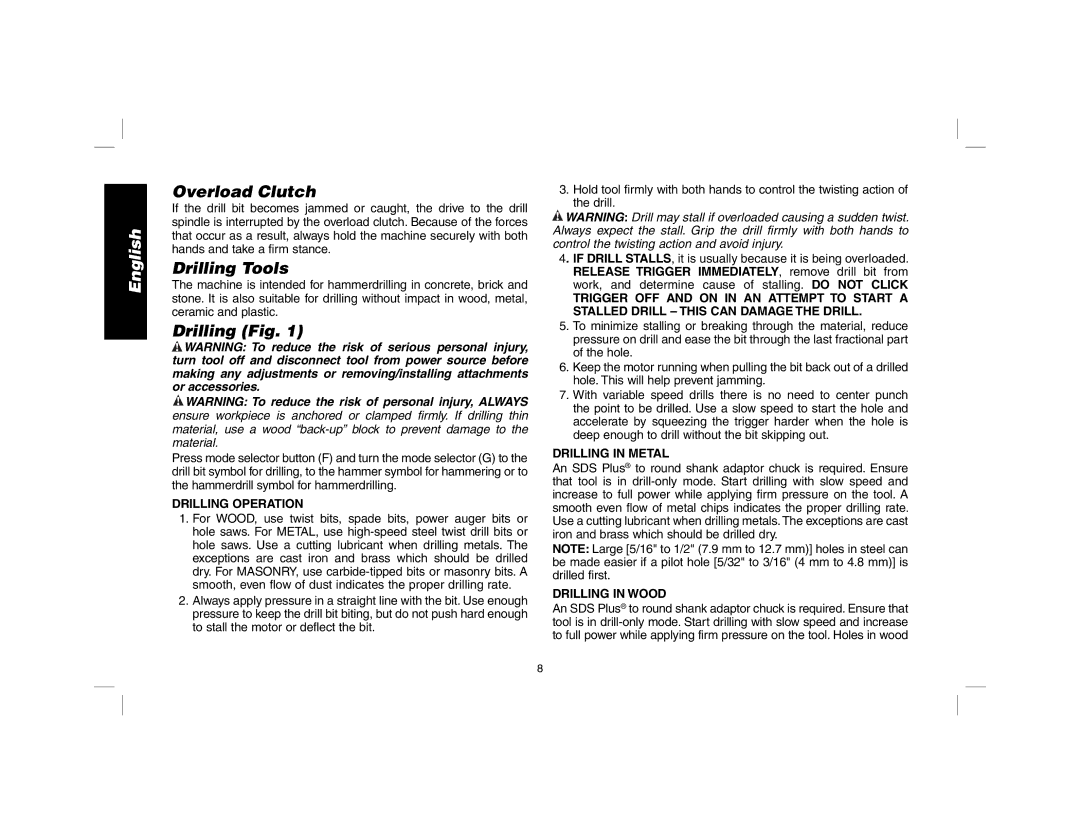
English
Overload Clutch
If the drill bit becomes jammed or caught, the drive to the drill spindle is interrupted by the overload clutch. Because of the forces that occur as a result, always hold the machine securely with both hands and take a firm stance.
Drilling Tools
The machine is intended for hammerdrilling in concrete, brick and stone. It is also suitable for drilling without impact in wood, metal, ceramic and plastic.
Drilling (Fig. 1)
![]() WARNING: To reduce the risk of serious personal injury, turn tool off and disconnect tool from power source before making any adjustments or removing/installing attachments or accessories.
WARNING: To reduce the risk of serious personal injury, turn tool off and disconnect tool from power source before making any adjustments or removing/installing attachments or accessories.
![]() WARNING: To reduce the risk of personal injury, ALWAYS
WARNING: To reduce the risk of personal injury, ALWAYS
ensure workpiece is anchored or clamped firmly. If drilling thin material, use a wood
Press mode selector button (F) and turn the mode selector (G) to the drill bit symbol for drilling, to the hammer symbol for hammering or to the hammerdrill symbol for hammerdrilling.
DRILLING OPERATION
1.For WOOD, use twist bits, spade bits, power auger bits or hole saws. For METAL, use
2.Always apply pressure in a straight line with the bit. Use enough pressure to keep the drill bit biting, but do not push hard enough to stall the motor or deflect the bit.
3.Hold tool firmly with both hands to control the twisting action of the drill.
![]() WARNING: Drill may stall if overloaded causing a sudden twist. Always expect the stall. Grip the drill firmly with both hands to control the twisting action and avoid injury.
WARNING: Drill may stall if overloaded causing a sudden twist. Always expect the stall. Grip the drill firmly with both hands to control the twisting action and avoid injury.
4. IF DRILL STALLS, it is usually because it is being overloaded. RELEASE TRIGGER IMMEDIATELY, remove drill bit from work, and determine cause of stalling. DO NOT CLICK
TRIGGER OFF AND ON IN AN ATTEMPT TO START A STALLED DRILL – THIS CAN DAMAGE THE DRILL.
5.To minimize stalling or breaking through the material, reduce pressure on drill and ease the bit through the last fractional part of the hole.
6.Keep the motor running when pulling the bit back out of a drilled hole. This will help prevent jamming.
7.With variable speed drills there is no need to center punch the point to be drilled. Use a slow speed to start the hole and accelerate by squeezing the trigger harder when the hole is deep enough to drill without the bit skipping out.
DRILLING IN METAL
An SDS Plus® to round shank adaptor chuck is required. Ensure that tool is in
NOTE: Large [5/16" to 1/2" (7.9 mm to 12.7 mm)] holes in steel can be made easier if a pilot hole [5/32" to 3/16" (4 mm to 4.8 mm)] is drilled first.
DRILLING IN WOOD
An SDS Plus® to round shank adaptor chuck is required. Ensure that tool is in
8
